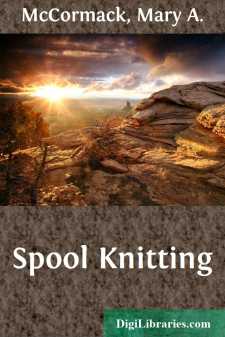Categories
- Antiques & Collectibles 13
- Architecture 36
- Art 48
- Bibles 22
- Biography & Autobiography 813
- Body, Mind & Spirit 142
- Business & Economics 28
- Children's Books 17
- Children's Fiction 14
- Computers 4
- Cooking 94
- Crafts & Hobbies 4
- Drama 346
- Education 46
- Family & Relationships 57
- Fiction 11829
- Games 19
- Gardening 17
- Health & Fitness 34
- History 1377
- House & Home 1
- Humor 147
- Juvenile Fiction 1873
- Juvenile Nonfiction 202
- Language Arts & Disciplines 88
- Law 16
- Literary Collections 686
- Literary Criticism 179
- Mathematics 13
- Medical 41
- Music 40
- Nature 179
- Non-Classifiable 1768
- Performing Arts 7
- Periodicals 1453
- Philosophy 64
- Photography 2
- Poetry 896
- Political Science 203
- Psychology 42
- Reference 154
- Religion 513
- Science 126
- Self-Help 84
- Social Science 81
- Sports & Recreation 34
- Study Aids 3
- Technology & Engineering 59
- Transportation 23
- Travel 463
- True Crime 29
Spool Knitting
Categories:
Description:
Excerpt
SPOOL KNITTING
Few elementary exercises have aroused more interest in the child than the toy knitting; due, perhaps, to its simplicity and his power to do it easily and well.
To some keen observer the little orb-weaving spider may have suggested this form of occupation. Be this as it may, the child who is a lover of nature will be quick to perceive the strong resemblance he bears to this little insect while at work with his toy knitter, going from post to post just as the insect worked its net in spiral form on his framework of radiating lines.
The possibilities of an empty spool and a few pins are almost without limitations. The illustrations here given are merely suggestive of many more that can be worked out along these lines. They are not simply to momentarily attract the child, but to permit of individual growth, and to have him participate in the joy of its ultimate use.
Toy knitters are made of a cylindrical piece of wood two and one-half or three inches long and at least one inch in diameter. This size enables the child to grasp it easily and work without cramping the fingers. A hole one-fourth or one-half inch in diameter is bored lengthwise through the center to admit the work. Spools are used to advantage where knitters cannot be obtained.
Pins, staples, or wire nails are used as posts. These are driven into the wood and then curved outward a little at the top with pliers, to prevent the work from slipping off. One, two, three or four posts may be used.
A number of forms of web can be made, but the simplest and quickest are those made on the knitters having but two posts. The four-post knitters are also simple and are used where a thick cord is needed.
Except otherwise specified two-post knitters are used for these models.
Round Web
Drop worsted through the hole in the center of the knitter and draw it out at the other end, three inches. This end is used to draw the work through the knitter. Carry the worsted leading from the ball, around the post to the right, across the center of the hole in the knitter and around the post to the left; then back across the center to the post at the right, thus making two stitches on this post. Lift the lower or first stitch with a large pin or knitting needle, carry it over the second stitch and drop it over the post; then across the center to the post at the left and repeat. So continue until the desired length is obtained.
It will require seven yards of yarn to make one yard of web on the two-post knitter.
Begin in the same way as for round web, but after carrying the first or lower stitch over the second stitch on each post, bring the worsted back around the same post, and over to the post on the opposite side and repeat. This will leave two stitches on each post. In knitting flat webs, two stitches must always be left on the end posts, and these two are carried over the third stitch and dropped over the post in working back and forth.
It requires eleven yards of yarn to make one yard of flat web on the two-post knitter.
...












